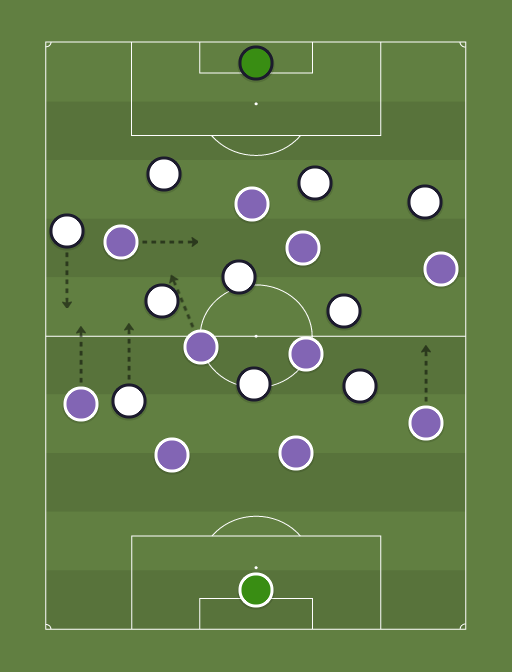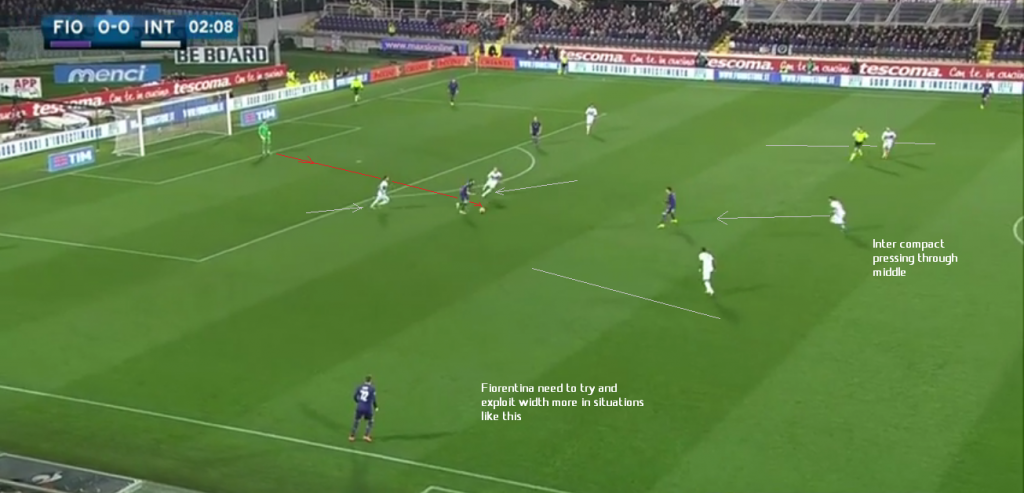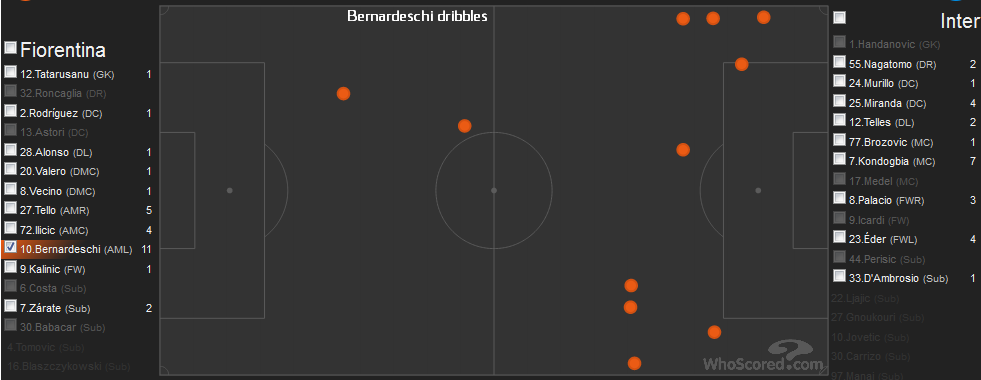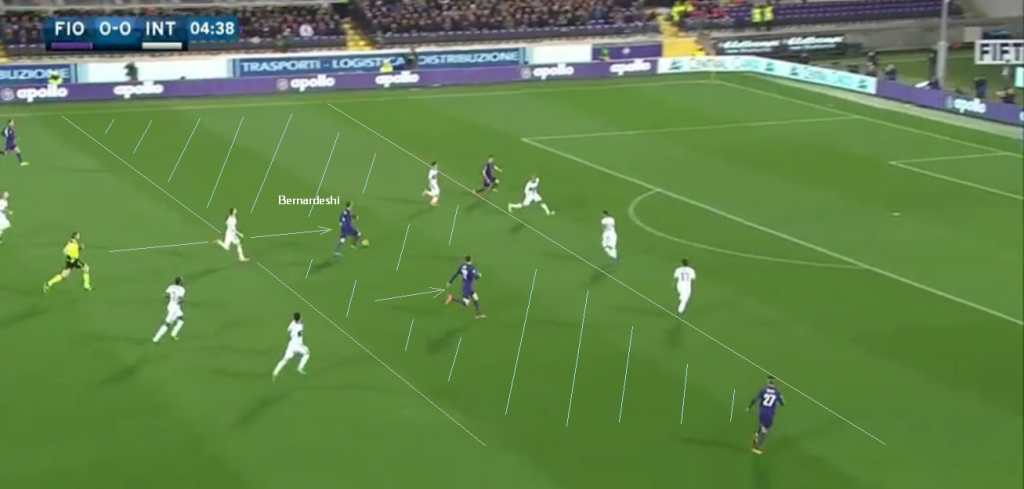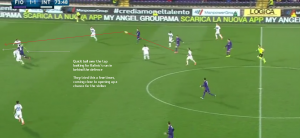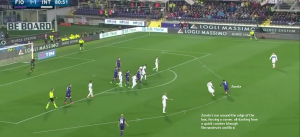Both teams came into the match with form that had tailed of from the first half of the season, but with Inter having the worst of it recently. A third place finish is still up for grabs, and this game would seemingly give us a big indication as to who was favourite in the chase for Champions League football next season. Sousa’s side won the reverse fixture in September at the San Siro by the considerable 4-1 scoreline. They also boast a good home record of 9 wins in 12 games in Serie A this season. Inter’s away record is also good, but they’ve failed to score more than once on all but 3 occasions and failed to win in the last 3. Viola fielded what was effectively a 4-2-3-1, with Valero once again in the holding position alongside Vecino, deputising in that role as a result of the injury to Badelj. Bernardeschi and Tello occupied the wings, with Ilicic and Kalinic restored up front. Fernandez suspended after last week. Inter’s line-up was familiar to last week’s, but with Medel replacing Melo in the middle, and Miranda dropping back in alongside Murillo. Ljajic, Perisic and Jovetic all left on the bench once again.
High pressing, high energy
Both sides were intent on closing down their opponents high up the pitch. This wasn’t a particularly surprising strategy for Inter to implement, given Fiorentina’s reliance on possession and build up from deep, but it was a question of whether they could disrupt the home side’s rhythm enough. A period of poor passing, overlapped with intense pressure from Inter, could have resulted in momentum and chances for Mancini’s side early on – but it was actually Fiorentina who grew into the game more in the first half. They also pressed Inter when given the chance in the final third, and both teams were guilty of the occasional sloppy pass. The first real example of the pressing tactics was when Tatarusanu had a goal kick, and Inter dared him to pass it out – which he did – through the two attackers. The ball ended up being worked out wide and may have created an attack, but there were two points of danger that could have left Viola exposed: the initial pass from the keeper to the centre-back under pressure, and the next pass on to the midfielder (Bernardeschi in this case) who was also closely followed. If either of these passes are intercepted, Inter then have the ball in the centre of the pitch with seven men in Fiorentina’s half waiting to attack. This is where the high-pressure can be beneficial not just for the attackers, but it means that the midfielders become the second wave of pressing. It forces the opposition receiver of the ball to play with his back to goal, as he comes deep to give the defender on the ball an option to pass to, and have a very good first touch to retain possession. However, the danger then is that the pressing team get sucked too high up the pitch, exposing themselves to a long pass or flick round the corner that starts a counter-attack.
Ilicic and Kalinic both showed willing to close down Inter men as well in the opening 15 minutes, and the game was scrappy at times as neither team could get much space. A key area for Fiorentina was out wide, where they looked to stretch the play and use Tello in particular to do this down the right. Around ten minutes in, there was a point where Alonso moves up the pitch and presses Brozovic on the ball, ultimately gaining possession back for his team. From this, the home side switch the ball across their defence and quickly out to Tello on the touchline, who gets the first real chance to use his pace – knocking the ball past Telles and drawing a yellow card for the Inter defender as he blocks him off. This all came about from Alonso’s tenacity to get the ball on one wing, and then retain possession so that they could move it across the pitch. Unfortunately, this use of Tello was relatively few and far between – an area that they could have exploited more, particularly after Telles’ yellow card.
Bernardeschi
As he has been for large parts of this season, Fiorentina’s young winger was in good form and causing problems for the opposition. The instructions for Tello on the right were clearly to stay on the right, however Bernardeschi appeared to have the freedom to roam inwards and try to disrupt the opposition with his movement and unpredictability. His first major contribution was on the counter-attack, as Ilicic does well to retain the ball from deep whilst surrounded by white shirts, and then passes forward to Bernardeschi. From this point, he is just inside his own half and running through the centre, and gets to within about 5 feet of Inter’s penalty area before someone attempts a tackle. He skips past Miranda’s outstretched leg, moves into the area and shoots at Handanovic from a wide angle – the shot parried but offside eventually given against Kalinic. It was the first real sign of danger, as Bernardeschi got between the lines of defence and attack (even though it was still in his own half at the time when he received the ball) and was given the opportunity to run at goal. A similar attack came about ten minutes later, although this time it was Ilicic running through the middle with a 4-on-3 developing. Bernardeschi made the run on the outside and received the pass, bursting into the box, but instead of shooting he cuts the ball back to Ilicic who’s shot is somehow blocked on the line by Telles. It was Viola’s best chance of the half, and came about from a quick break and good decision making from the young winger to pull the ball back to his team mate who was free in the middle.
Another chance materialised for Bernardeschi around the 20 minute mark, when he got between the lines again, receiving the ball from Astori from deep. Its from here that he can turn and drive into the area, playing a lovely one-two with Kalinic, only for a foul to be given as he received the return. There was a big call for a penalty, but the decision went the other way – with the referee claiming a push on Miranda before he went down. However, the move highlighted the danger of Bernardeschi operating in that space between Inter’s midfield and defence, allowed to roam from wide to the middle, in those occasions where Brozovic, Medel and Kondogbia are caught ahead of the ball and Inter on the back foot. Its a trick that we’ve seen a few teams in Europe use this year – the left centre-back picking the ball up, moving towards the halfway line and playing a through pass to the attacking midfielder who can turn and then either (a) run at the defence (b) play a dangerous pass to the striker. Other examples being Koscielny to Ozil and Chiellini to Dybala. It was an area of the pitch that, by the nature of the players in Inter’s midfield, was going to be pretty restricted – but Bernardeschi was there to try and take advantage of any gaps opening up.
Inter goal & Palacio’s work
The first goal came against the run of play, but was a great one nonetheless. There were multiple aspects to it that should be praised, but the key men here were Brozovic, Kondogbia and Palacio. Brozovic played a nice one-two with Kondogbia who cushioned the ball mack to him and allowed the Croatian to move into the opposing half. He passes it forward to Palacio who was moving in from the left, cutting in field to lay it back to Kondogbia. Palacio then continued his run into the box to receive the through pass, cut it back at the byline and see Brozovic running in to blast goalwards in the area. It was a great team goal, and one that is not easy to criticise on Fiorentina’s part, but it was avoidable. The threat really began to unfold when Kondogbia received the ball 25 yards from goal and had a lot of space to take his time and wait for Palacio’s run. Valero had committed to moving away from Kondogbia to pressure Palacio on the ball, which left the Frenchman with space. Astori recognised this, and tried to run out and engage him, but this only served to further free the area in behind – which Palacio run into. When he eventually crossed into the middle, Brozovic was completely unmarked and had an easy finish. Roncaglia leaves Brozovic and gets drawn to Icardi in the middle with Rodriguez, meaning that the Croatian is alone when the cross evades everyone at the front post. It wasn’t great defending, but also probably caught Fiorentina by surprise, having been pretty quiet so far.
Palacio’s influence was noticeable, not just going forward, but also defensively. He was there on multiple occasions, as his team tucked back and defended in shape, to help out particularly in full-back areas. He tries to read the attack early, and positions himself where he can quickly sprint to try and cover any route that Viola take to get to goal (pic below). However, he is also often used to combat the width offered by Marcos Alonso getting forward, and an interesting battle occurred at times between the two. Palacio started the second half by effectively sticking on Alonso, not letting him gain any ground. This in turn can have the effect of pushing Bernardeschi further infield, where he likes to roam. Palacio actually got Alonso booked shortly after the start of the second half by knocking the ball past him and being dragged back.
Fiorentina’s goal & change of tempo
The equaliser came on the 60 minute mark, through an unlikely source – a header from Valero. Initially, Fiorentina had the ball on the left, and Inter had fallen back into the familiar shape defending their own area. Alonso managed to cut inside of Palacio this time, and pass infield to Valero, who switched it out to Roncaglia as he came forward. When Ilicic then picked up the ball off of his right-back, he could drift in from the right slightly to whip in a great cross – one which would skim off of Murillo’s head and on to Valero who was waiting at the back post. Roncaglia’s run was important, as he continued forward after laying the ball off to Ilicic – it meant that he dragged Eder away from the crosser, and in that moment where Telles realised he had to close it down, that was the point where Ilicic got enough time to pick a perfect cross. Inter’s defensive line doesn’t quite work – the run from Valero is well-timed and Murillo gets under the ball, only managing to flick it on to Valero. They manage to play Kalinic offside, and Miranda is occupied by Zarate moving in front of him, but Nagatomo does nothing other than try to step up and play offside – leaving Valero to run in free. Brozovic is perhaps guilty of not tracking Valero, but he probably thought that one of his defenders would cope with the threat, as it happens the run was perfect and the flick-on met the Spaniard’s head.
The equaliser was a bit of a surprise, coming out of nothing really, but it triggered a period of play that was quicker and slightly more direct. This would have been somewhat down to the conditions (heavy rain at this point) and Viola’s need for a goal. Zarate, who straight away brought intensity to the game, was introduced for Tello just before the goal. After the equaliser, the pace quickened, and there was even more of an urgency from Sousa’a side to get the ball from defence to attack fast. There was an attack in the 63rd minute that came from a direct through ball to Kalinic who had made a good run (something he did more of after the interval), and managed to turn, eventually working the ball out to Alonso who put in a whipped cross (pic below). As the ball went for a corner, there was a deafening roar from the crowd as they felt the intensity go up a notch and the home team get right back into the game. This was compounded by a strong penalty claim moments later, for which the referee waved away the shouts. The speed of Fiorentina’s passing and their pressing on Inter high up the pitch increased, to the point where Inter desperately needed a period of play to calm things down again. Borja Valero was a big catalyst of this, along with Zarate when he came on. Sousa had clearly given up some of the passing accuracy and calculated nature of his team’s build-up in favour of this speedier approach.
Inter briefly got that respite, and some renewed hope with the introduction of Perisic, who straight away got on the ball and put a cross in from the left. Roncaglia was then the only man stopping Perisic getting on the end of a Palacio cross from the opposite side moments later. He had another opportunity to get a cross in a few minutes after, but elected to cut back and the subsequent cross was blocked. Kalinic continued to make runs in behind the away side’s defence, which was causing problems at times. However it was Bernardeschi that instigated a pivotal moment, when he picked up the ball on the right and had the opportunity to run at Telles. The Brazilian left-back was caught square-on and stuck his leg across Bernardeschi, touching the ball away in the process. The ref failed to see, or appreciate, Telles’ touch on the ball and subsequently gave him a second yellow card – leaving Inter to try and see out the remaining ten minutes with ten men. In reaction, Mancini brought D’Ambrosio on for Palacio, and shortly after Sousa brought on Tino Costa and Babacar in a statement of intent. Fiorentina continued their high-pressing in the final minutes, looking to win the ball back as quickly as possible to launch an attack, or forcing Inter to kick long and give-up possession. To their credit, Inter also did the same thing, really trying to hassle the Viola men on the ball in both halves of the pitch. They had a half-chance to get in on goal, after Valero gave the ball away cheaply, breaking with Brozovic through the middle, but his pass to Icardi prompted the linesman to raise his flag and alleviate Sousa’s annoyance. However, in added time, it was Fiorentina who landed the killer blow. Alonso got the ball wide on the left and slipped a nice pass through to Zarate as he ran into the area from an angle. The Argentine then managed to cut back and whip the ball towards the far post, which Handanovic parried out straight into Babacar’s path – causing the ball to ricochet back into the net. The key to the goal was Zarate’s run, which was unguarded by Brozovic and seen late by Kondogbia who had to run in at speed, leaving him susceptible to the cut back from Zarate. The save from Handanovic was questionable, as he parried it straight back out into danger, but Babacar was lurking in the right place – between the two defenders – to meet the rebound ahead of Nagatomo.
The match was marred slightly by a ridiculous period at the end of the game, which saw a red card for Zarate for an off-the-ball incident where he appears to grab the back of Murillo’s neck, and a throw-in take almost three minutes. However, Fiorentina managed to hold on for a memorable victory that leaves them third in the table and Inter down in fifth. Mancini will now also have to deal with the suspensions of Telles and Kondogbia (who appeared to be sent off after the final whistle). Sousa will be happy with the way his team managed to influence the game by changing the tempo in the last 35 minutes or so, battling hard for the two goals. His substitutes certainly made an impact as well. Mancini on the other hand, is left waiting for his side’s form to turn, and will be disappointed at the lack of clear opportunities they had to seal a win. Both goals came from balls into the box, something they were so dominant at defending earlier in the season, as the defensive rigidity of the Nerazzurri appears to be fading slightly. Both teams will be looking to fend off the challenges of Roma, and Inter must now have a watchful eye on their city rivals who lie just two points behind.
* * *
Fiorentina 2-1 Inter
(Valero 60′, Babacar 90+1; Brozovic 26′)
